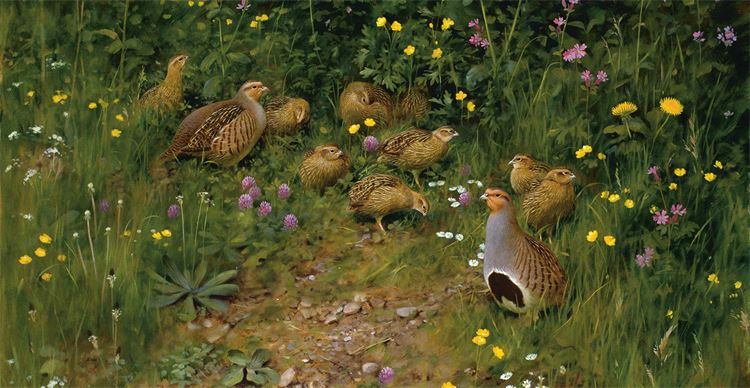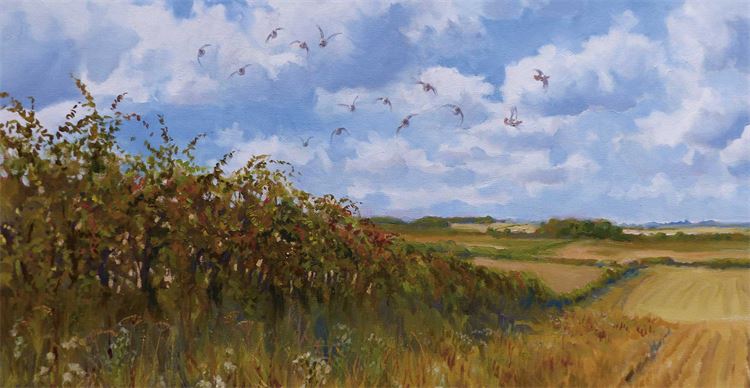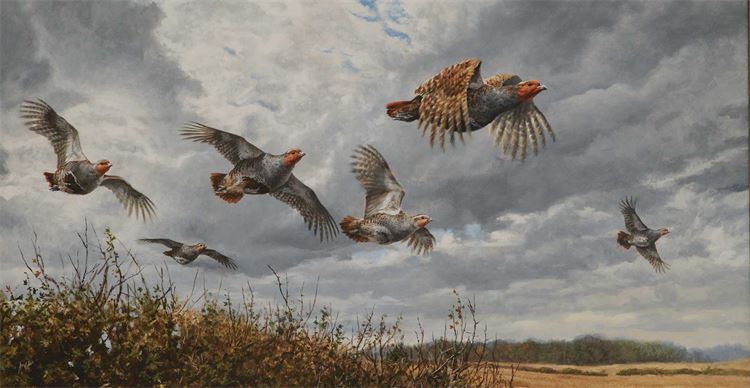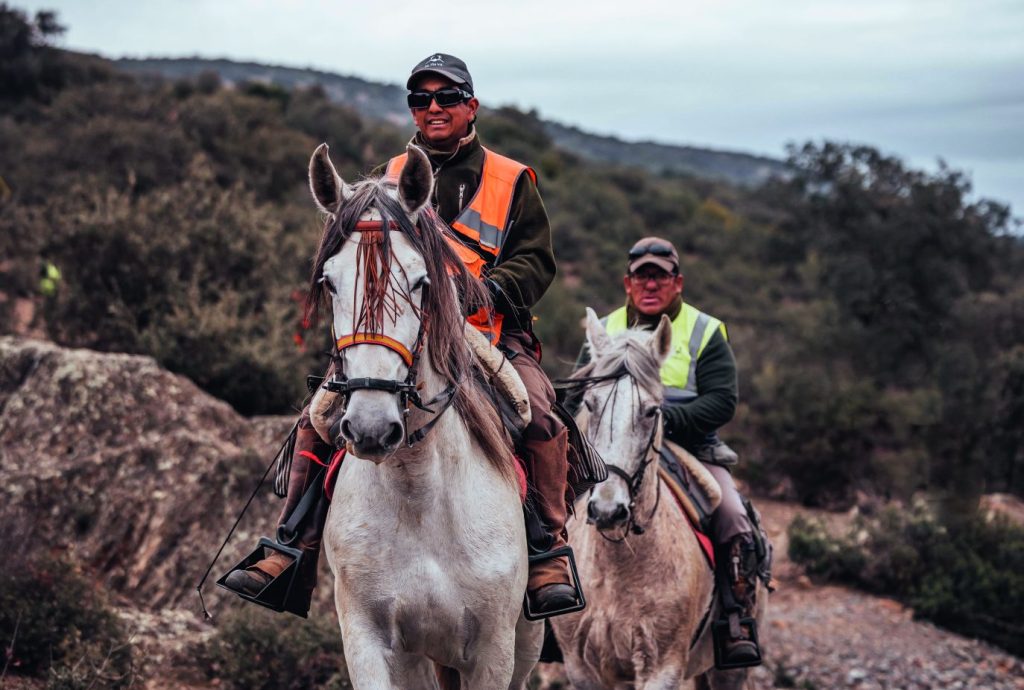A love of Englishmen
Three of today’s foremost sporting artists consider the allure of grey partridges, in the field and at the easel.

Rodger McPhail
Over the past 40 years I have painted hundreds of pictures of grey partridges. During this time they have disappeared from nearly all of their former haunts. Yet they are just as popular now as when they were a familiar and ubiquitous quarry.
What is it about this bird that demands such lasting affection? Apart from providing wonderful sport and delicious meals, the partridge has many admirable qualities. It is modest, unshowy, parochial and discreet. It is a staunch monogamist – a partridge pair are devoted and inseparable. Both parents are tirelessly attentive to their numerous chicks and are fearless in their defence.
For an artist they are irresistible. There is a cosy plumpness to their shape that I find most endearing, and the subtle delicacy of the plumage is inspiring. Although I haven’t shot a grey for many years, I never tire of painting them.
This little gamebird inspires a deep affection that we simply do not feel for pheasants or even redlegs. Like most sportsmen over the age of 50, the grey partridge was the first gamebird I ever shot. Every scruffy bit of farmland had a covey and their creaking calls were as familiar as the cooing of woodpigeons. Now they are gone apart from a few bits of wild hillside and those precious areas where dedicated landowners have put huge amounts of effort, time and money into halting the decline.
These days the popularity of this iconic bird is due to pure nostalgia. Most young sportsmen have never seen, let alone shot one. The grey partridge has become a symbol of a countryside that has disappeared, an emblem of a golden age that probably never existed. We can only hope that with research, determination and a few changes in land management, the ‘English’ will once more become as familiar and widespread as it was in the past.
Jonathan Yule
The fields surrounding my boyhood home in Essex stretched away into the distance towards a shimmering ribbon of the sea. A line of magnificent elms extended from east to west across this vista. On summer evenings the distinctive call of grey partridges was, to me, an intrinsic part of this landscape. These were the days when grey partridges, corn buntings, skylarks and turtle doves were commonplace. Now, I fear, they are no more in those flat, fertile Essex fields – gone, like the mighty elms.
Here in Norfolk and up and down the land some 50 years later, thankfully we have a few enlightened landowners and keepers who are working incredibly hard to make the conditions suitable for the ‘greys’. A labour of love, at the mercy of the weather and requiring huge commitment in enthusiasm and resources. The reward, when populations allow, is one of the most exciting and, to me as an artist, inspiring of all quarry species. A covey bursting over a Norfolk hedge is one of the finest sights in the shooting field. It represents huge effort, care and love for this noblest of lowland gamebirds. Whenever I hear their call on a still evening when all is quiet, I experience a wave of nostalgia for those far away days in my native Essex.
I very much hope that this commitment to the conservation of the grey partridge will endure up and down the land well into the future.
Andrew Ellis
As a boy I never experienced the golden heyday of this little, quintessentially English gamebird. It was already in that imaginary place of ‘if only land’ that I had conjured in my mind’s eye. A land full of weedy, rough field boundaries, old farm machinery left rusting, the air humming with insects. It was, and still is, a nostalgic totem of homeliness and darling buds of May England.
With young curiosity, I would talk to old farmers with lost love in their voices of remembered coveys on almost every farm. This brown-grey, rotund, soft-eyed bird has so captured a place in our hearts and minds. It’s peach-faced, scratching call, the bold as brass males with horseshoes on their bellies.
Fast forward 30-plus years and I now live in a place that is gifted with this bird’s presence in good numbers – a corner of Northumberland that is forever wild. I now know the lift of heart that generations before me experienced when stumbling onto a covey in deep dry grasses, the whir of wings and the staccato scratchy alarm calls as they erupt and glide away on twisting, rocking wings.
My early years of adulthood were spent in late summer trying my hardest to release greys onto once blessed areas. Much of my efforts failed as I now realise these places had changed, lost what was essential. But in that brief time of late autumn, I experienced the thrill of a covey cresting a hedge on buzzing wings and star-bursting in different directions. An honest gamebird that would hold to a point, and fly with commitment and spirit.
As a painter of birds, the grey partridge has a subtle dryness of character, a dust-bathing mix of greys, russet bars and an ivory bill. A bright eye and upstanding character.
It is a bird of the eastern European grassland steppe, yet we have made it English. It has become strawberries and cream, honeysuckle, and cider apples.
Related Articles
Get the latest news delivered direct to your door
Subscribe to Fieldsports Journal
Elevate your experience in the field with a subscription to Fieldsports Journal, the premium publication for passionate country sports enthusiasts. This bi-monthly journal delivers unparalleled coverage of game shooting, fishing and big game across the UK and beyond.
Each issue offers a stunning collection of in-depth features, expert opinions and world-class photography, all presented in a timeless yet contemporary design.
Save 10% on shop price when you subscribe, with a choice of packages that work for you. Choose from Print & Digital or Digital only with each journal delivered directly to your door or via the app every other month, plus access to past issues with the digital back issue library.










